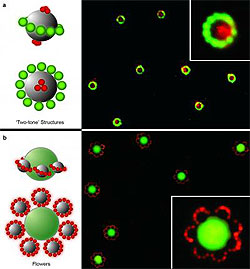DURHAM, N.C., Feb. 19, 2009 – By manipulating the magnetization of a liquid solution, researchers from Duke University and the University of Massachusetts Amherst have for the first time coaxed magnetic and nonmagnetic materials to form intricate nanostructures. The resulting structures can be “fixed,” meaning that they can be permanently linked together. This raises the possibility of using the structures as basic building blocks for such diverse applications as advanced optics, cloaking devices, data storage and bioengineering.
Changing the levels of magnetization of the fluid controls how the particles are attracted to or repelled by each other. By appropriately tuning these interactions, the magnetic and nonmagnetic particles form around each other much as a snowflake forms around a microscopic dust particle.
“We have demonstrated that subtle changes in the magnetization of a fluid can create an environment where a mixture of different particles will self-assemble into complex superstructures,” said Randall Erb, a fourth-year graduate student.

Newly formed nanostructures. Image courtesy of Duke University.
He performed these experiments in conjunction with another graduate student, Hui Son, in the laboratory of Benjamin Yellen, assistant professor of mechanical engineering and materials science and lead member of the research team.
The nanostructures are formed inside a liquid known as a ferrofluid, a solution with suspensions of nanoparticles composed of iron-containing compounds. One of the unique properties of these fluids is that they become highly magnetized in the presence of external magnetic fields. The ferrofluids used in these experiments were developed with colleagues Bappaditya Samanta and Vincent M. Rotello at the University of Massachusetts.
“The key to the assembly of these nanostructures is to fine-tune the interactions between positively and negatively magnetized particles,” Erb said. “This is achieved through varying the concentration of ferrofluid particles in the solution. The Saturn and flower shapes are just the first published examples of a range of potential structures that can be formed using this technique.”
Yellen said that researchers have long been able to create tiny structures made up of a single particle type, but that the demonstration of sophisticated structures assembling in solutions containing multiple types of particles has never before been achieved. The complexity of the nanostructures determines how they can ultimately be used.
“It appears that a rich variety of different particle structures are possible by changing the size, type and/or degree of magnetism of the particles,” Yellen said.
He foresees the use of these nanostructures in advanced optical devices such as sensors, where various nanostructures could be designed to possess custom-made optical properties. He also envisions that rings composed of metal particles could be used for antenna designs, and perhaps as one of the key components in the construction of materials that display artificial “optical magnetism” and negative magnetic permeability.
In the Duke experiments, the nanostructures were created by applying a uniform magnetic field to a liquid containing various types of magnetic and nonmagnetic colloidal particles contained between transparent glass slides to enable real-time microscopic observations of the assembly process. Because of the unique nature of this “bulk” assembly technique, Yellen believes that the process easily could be scaled up to create large quantities of custom-designed nanostructures in high-volume reaction vessels. However, the trick also is to be able to glue the structures together, because they will fall apart when the external field is turned off, he said.
“The magnetic forces assembling these particles are reversible,” Yellen said. “We were able to lock these nanostructures in their intended shapes both by using chemical glues and by simple heating.”
To create new types of nanostructures, the Duke team plans to test different combinations of particles and ferrofluids developed by the University of Massachusetts team. The researchers also want to try to make even smaller nanostructures to find the limitations of the assembly process and to study the interesting optical properties that are expected from these structures.
“While we have shown that we can get small magnetic particles to form complex and beautiful structures, we believe that, based on theory and the results of preliminary experiments, we should be able to manipulate even smaller particles by using other magnetic particles and ferrofluids,” Yellen said.
The research was supported by the National Science Foundation.
For more information, visit: www.duke.edu